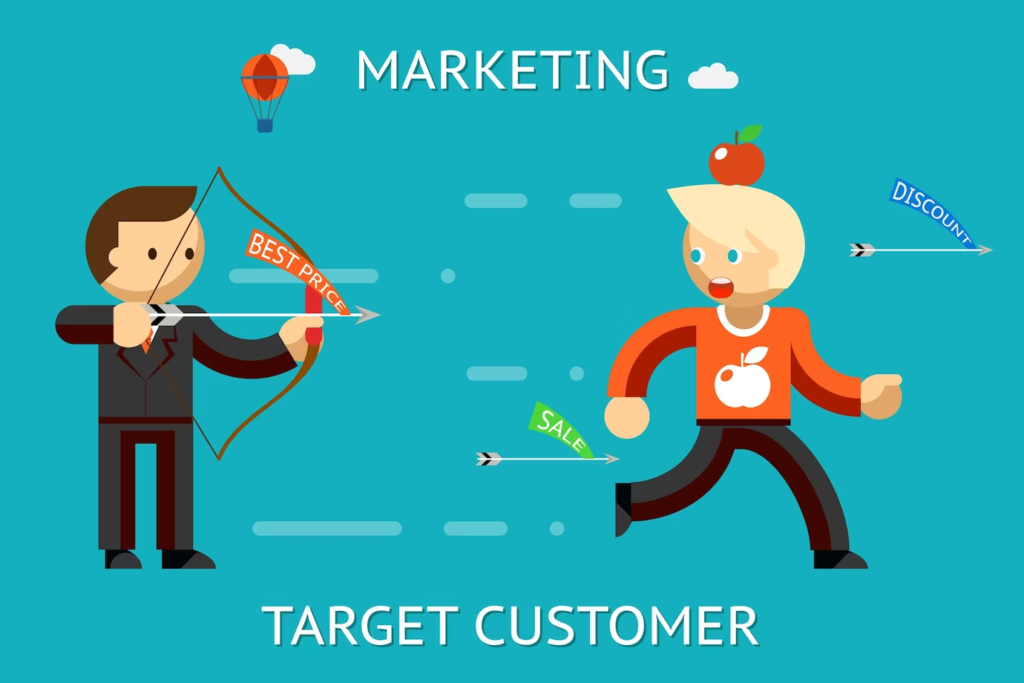
The service marketers have realized that it is not desirable to address the whole market with their offers. There is a need to choose the markets and target them with its service offers. Target Marketing recognizes that different groups of customers have different needs and might also desire different core benefits from the same services. Lets see the Strategy of Target Marketing in detail.
Definition of Target Marketing
- The process of identifying market segments, selecting one or more of them and developing a marketing mix to meet their needs is known as target marketing.
- It sought the different needs and preferences of the customers and instead of trying to satisfy them with the same type of services, the firm designed complete marketing programmes for each of these groups

Benefits of Target Marketing
- It generates customer loyalty.
- Customer requirements vary widely.
- Smaller firms can seek niche or specialized markets.
- More cost effective.
Three Stages in strategy of target marketing
- Market Segmentation
- Market Targeting
- Product Positioning
Target Marketing and Segmentation
- Concept developed by Wendell R Smith.
- It is a process of dividing a heterogeneous market into a homogenous sub – units.
- Kotler – Dividing a market into distinct groups with different needs, characteristics or behaviour who might require separate services.
- Customers inside a grouping had similar preferences and traits; two different groups had different preferences and traits.
- Each of these groupings was called a segment and also the process was known as market segmentation.
Market Targeting
- The service marketers evaluates these groups and chooses those groups which it perceives it could cater to with its available resources.
- If a service marketer chooses only one segment, then it is focus or concentrated marketing, whereby his attention is on a single market, known as niche market.
- If he choose a few of the segments, then it is a multi segment strategies, where a series of separate marketing activities designed for different market segments.
- Multi segment strategies are the prerogative of larger service firms, attempting to conquer different segments through different marketing programmes. More scope for expansion and growth with this strategy but it is more expensive and also need more expertise.
Target Marketing and Positioning
- It is the battle for consumer mindshare
- The chosen segment is to be targeted for customer acquisition and retentions. For this to be successful, customers have to be persuaded that the service offer is unique in features, value & benefits.
- The offer, thus, has to be positioned in their minds to enable them to recognize the offer as distinct from the crowd and also to persuade that the offer I the best offer for them.
Strategy of Target Marketing

Market Targeting – Strategy of Target Marketing
The following are the strategies in Market Targeting.
1. Undifferentiated Strategy– Whole market is one.
- Advantages– EOS, Maximum utilisation of resources, cost effective and specialisation.
- Disadvantages– Ignores consumer concerns.
2. Differentiation Strategy– targets different segments differently.
- Advantages- Varied coverage, Efficient use of resources, increased sale.
- Disadvantages– Multiple marketing mix, increased cost.
3. Niche/Concentrated Marketing– Here marketers targets large share of one or few segments (niche).
- Advantages- Useful for small firms, Specialisation, cost effective.
- Disadvantages– Risk, Competition.
4. Micro Marketing– Products suited to specific needs of specific individuals or local customer group.
- Local marketing- Delhi Milk Scheme
- Individual marketing- One to one marketing. E.g- building villas, customised suit etc.
- Advantages – Higher customer satisfaction, efficiency etc.
- Disadvantages – Costly and time consuming
Strategy of Target Marketing – Product Positioning
The way in which a firm’s product is perceived by the customers in relation to competitor’s product. The following are the strategies in Positioning
- On the basis of product characteristics- Shampoos claim smooth and silky hair, Car company talks about economic aspect in fuel etc.
- Basis of Price
- Basis of Quality
- Basis of User- Sachin– Boost, Aishwarya- L’Oreal etc.
- Basis of Use
- Basis of Product Class – Milano is premium product of Parle.
- Basis of Logo
Market Segmentation – Strategy of Target Marketing
The following are the strategies in Market segmentation
- Geographic Segmentation– It focuses on dividing markets into different geographic units based on region, states, rural, climate conditions etc.
- Demographic– Age group like infant, children, teenagers, young adults, Senior adults. Income level– Lower income group, Middle income group and also Upper income group. Gender, Social Class, Occupation, Education, Religion.
- Psychographic Segmentation- Based on Social Class, Personality and also Lifestyle.
- Behavioural Segmentation- Marketers divide the buyers on the basis of their knowledge about the product, attitude towards product and also their response to a product.
LIKE WHAT YOU’RE READING?
CHECK OUT SOME OF OUR OTHER GREAT CONTENT HERE:
- IMPACT OF MARKETING ON SOCIETY
- DEFINITION OF MARKETING MANAGEMENT
- ROLE OF BLOGS IN MARKETING
- WHAT IS AFFILIATE MARKETING? (HOW TO GET STARTED)
- EFFECTIVE BRANDING METHODS
- UNDERSTANDING DIGITAL MARKETING
- DECODING DIRECT MARKETING WITH EXAMPLES
- 5 BEST MARKETING STRATEGY IN PRODUCT LIFE CYCLE FOR 2023
- WHAT IS THE IMPORTANCE OF MARKETING IN A BUSINESS?
- DEFINITION OF B2C MARKETING WITH EXAMPLE
- WHAT IS THE CONCEPT OF BUSINESS ENTITY?




14 Comments